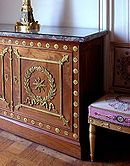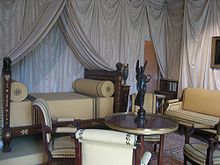Empire (style)

The Empire ([ ɑ'piːʁ ], fr. "Imperial") is an approximately the same time in France with government portions of the Consulate (1799-1804) and the first Empire predominant (1804-1815) flow of the fine arts , the the Classical subordinate is.
history
It developed in the last decade of the 18th century, spread under the influence of Napoléon Bonaparte in Europe, primarily in the areas under his influence ( Italy and the Confederation of the Rhine ), but also, for example, in Russia or the West Bohemian spa triangle , and lasted until 1815 . It mainly includes interior fittings, handicrafts and furniture art , but also clothing fashion (see revolutionary and empire fashion ). The period of classicism in architecture coincides with the Empire, but starts earlier and lasts longer.
features
The Empire style drew its ideals like classicism in general from Greek and Roman antiquity; besides decoration, its main goal was representation. In contrast to the previous, more delicate Louis Seize style , however, the Empire is characterized by greater monumentality. Straightforwardness, severity and solemnity should illustrate greatness and power.
The Empire is not to be confused with the art style called Second Empire within historicism at the time of Emperor Napoléon III.
Representative of the Empire style
The beginning was marked above all by the painter Jacques-Louis David , who glorified Napoleon as a general and emperor in his paintings .
The finest pieces of furniture art of this time were created by the cabinetmaker Georges Jacob (1739–1814) and his second son François-Honoré Jacob-Desmalter (1770–1841). Mahogany , ebony and cedar were preferred for the furniture, and the expression was enhanced with fire-gilded fittings (such as lion's feet), velvet and marble. Greek, Egyptian and Roman motifs were very popular in all areas.
"Empire" is also the name given to the French variety of classicist architecture, which in the course of the Napoleonic wars also strongly shaped Europe east of the Rhine. Leading the way were the architects, preferred by Napoleon, Pierre-François-Léonard Fontaine and Charles Percier .


